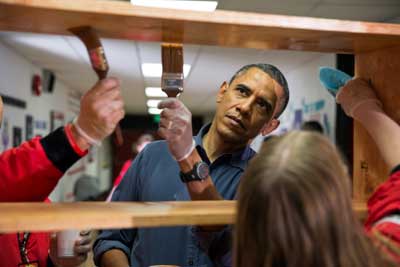
President Obama has been emphatic that his top priority for his second term is to defend the economic interests of the U.S. middle class. This is what he said in his inaugural address earlier today:
We believe that America’s prosperity must rest upon the broad shoulders of a rising middle class. We know that America thrives when every person can find independence and pride in their work; when the wages of honest labor liberate families from the brink of hardship. We are true to our creed when a little girl born into the bleakest poverty knows that she has the same chance to succeed as anybody else, because she is an American, she is free, and she is equal, not just in the eyes of God but also in our own.
It is hard to argue with these sentiments, as far as they go. But it would help a lot if Obama got a lot more specific very soon. Here are two specifics: get serious about fighting for 1) full employment and 2) a dramatic reduction in poverty. Both of these are eminently achievable over the next four years. They will also be wildly popular with the overwhelming majority of people, regardless of race, color, creed, sexual orientation or political affiliation.
Also See: Three Things Obama Can Do If He Is Serious About Promise to Middle Class
Starting with unemployment, Obama’s goal should be to cut the official rate in half by the end of 2016, from today’s level of 7.8 percent to 3.9 percent—the unemployment rate last achieved in 2000. This would be the single most important thing he could do to support middle-class well-being in this country. It would mean that nearly 7 million people who cannot find work today would become newly employed. But we also must not forget that, at present, 6.2 percent of the labor force is either underemployed—working part-time because they can’t get full-time—or too discouraged to have looked for work within the past few weeks. Obama should cut that figure in half as well by the end of 2016, creating new opportunities for an additional 6 million people and their families. The goal should therefore be at least 13 million more decent jobs by the end of 2016. As I have discussed in previous posts as in Back to Full Employment, pushing the unemployment rate down aggressively will also give workers more bargaining power, which in turn will deliver higher wages and better working conditions.
Now on poverty reduction: As of the most recent 2011 figures, 15 percent of all U.S. residents—46 million people—were living below the official poverty line (with the official poverty line being thoroughly inadequate for measuring conditions of economic duress in this country, as the U.S. Census Bureau itself recognizes). Obama should also set as his goal to also cut the official poverty rate to at least the rate achieved in 2000, which was just above 11 percent. Cutting the poverty rate in this country from 15 to 11 percent as of 2016 would mean a significant improvement in the lives of 13 million people.
Not surprisingly, there are also strong connections between the ups and downs of the poverty and unemployment rates. Of all the poor families in the country in 2011, 36 percent had nobody in the family working at a job. More generally, we can see from the figure below that the official unemployment and poverty rates have consistently moved closely together throughout the full period shown, 1970 – 2011. It is therefore no surprise that, as we see in the figure, from 2007—just before the Wall Street crash and Great Recession—the official poverty rate jumped from 12.5 to 15.0 percent. In short, the single best thing Obama could do for the middle class—to build a full employment economy—is also the single best thing he could do to fight poverty.
But is it just pie-in-the-sky to think that the U.S. could create 13 million or more decent jobs over the next four years? It would mean that job growth in the U.S. would have to average 2.2 percent over the next four years. Impossible? In fact, the most robust four years of job growth since World War II was in the expansion after the 1974-75 recession. Over the four-year period 1976-79, under Presidents Ford and Carter, employment grew at an average rate of nearly 4 percent per year. Yes, we are talking about the bumbling Gerald Ford, who got booted out of office after only 2 years; and Jimmy Carter, who defeated Ford, but whose economic stewardship is mostly recalled as having produced a national economic “malaise.” Shouldn’t Obama be able to deliver job opportunities for the middle class and poor at only slightly better than half the rate accomplished by the bipartisan team of Ford and Carter?
Of course, it is not up to Obama alone to achieve these goals. But if he is going to be effective in winning battles with Republicans and Wall Street Democrats for things that matter, he needs to have clear, tangible goals about what he is fighting for. These two goals couldn’t be more specific: by 2016, cut the official unemployment rate to 3.9 percent and the poverty rate to 11 percent, and once we get there, stay there.
Join us in defending the truth before it’s too late
The future of independent journalism is uncertain, and the consequences of losing it are too grave to ignore. To ensure Truthout remains safe, strong, and free, we need to raise $43,000 in the next 6 days. Every dollar raised goes directly toward the costs of producing news you can trust.
Please give what you can — because by supporting us with a tax-deductible donation, you’re not just preserving a source of news, you’re helping to safeguard what’s left of our democracy.